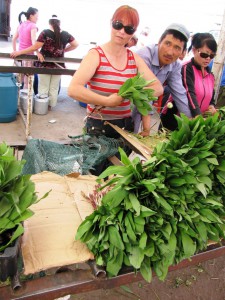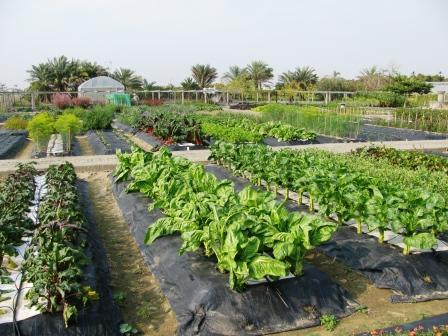- Cary Fowler on the need to breed.
- MRIs of fruits and vegetables. Well, why not?
- The genetic consequences of bovine inter-specific sex explained. SFW.
- How Mrs Joséphine Enoce Bouanga makes milk from squash seeds in Pointe-Noire.
- Gates Foundation orange sweet potato project in Mozambique. Still waiting to hear what they’re going to do with all those useless landraces they’ll be replacing.
- Nourishing the Future does Lost Crops of Africa 101. Beginners, start there, but don’t expect to be taken anywhere interesting.
- Blog carnival Scientia Pro Publica #35 is up, but what’s with the verse alphabetical order? Harummph.
AVRDC’s treasure trove of diversity
I was recently at AVRDC headquarters in Taiwan and was quite taken with their demonstration garden. (Among other things. The genebank operation is also impressive, and recovering from a recent unfortunate setback.) It’s a wonderful display of both vegetable diversity and cultivation systems. I was going to blog about it, but then life intervened, or at least work did. Anyway, the latest issue of AVRDC’s newsletter has a piece on the garden, and they have kindly agreed for us to reprint it here, as the newsletter itself is not available online. Which kinda gets me off the hook. The photographs are mine. The following text (and this post’s title) are courtesy of AVRDC.
Although there are thousands of plants people can consume, humanity relies on only a relative handful for food. Indigenous vegetables — whether semi-wild or domesticated — can greatly expand the menu. Grown primarily in their centers of origin or introduced in a given area, indigenous or traditional vegetables provide food in times of scarcity for the world’s poorest people, yet these hardy, nutritious species often are underutilized.
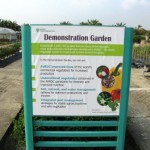
What began in 2001 as an experimental field on the grounds of the AVRDC headquarters campus in Shanhua, Taiwan has blossomed into a 0.63-hectare living example of the mission and work of AVRDC — The World Vegetable Center.
“The Demonstration Garden was designed as an observation plot for indigenous vegetables when we got the project from the Taiwan Council of Agriculture in the beginning,” said Mandy Lin, an assistant specialist in AVRDC Global Technology Dissemination. After 10 years of development, more than 60 different species of indigenous vegetables are cultivated in 200 plots of various sizes and shapes to showcase the special qualities of each species and promote their wider use. The range of species grown also maintains visual interest as the seasons change.
The indigenous vegetables in the garden were selected for three significant characteristics—ease of cultivation (low input), nutritional quality, and resistance to pests and diseases. Visitors touring the Demonstration Garden often are surprised by the number and variety of indigenous vegetables, and the different edible parts, from shoots and leaves to pods and seeds. “We want to convey a simple but principal message to every visitor—that a diverse diet including many different vegetables is beneficial to health,” Mandy said.
In July 2008 the Center’s Global Technology Dissemination group expanded the function of the Demonstration Garden to highlight four major mature technologies: low-cost drip irrigation, starter solution, grafting chambers, and protective shelters. Farmers in developing countries can adopt these technologies to increase yields, improve produce quality, and reduce production costs.
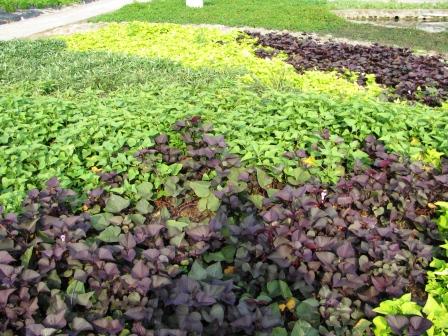
Visitors and AVRDC staff members alike gain new ideas and inspiration as they walk through the garden, enjoy the rich diversity of plants, and see farming technologies in use. As Mandy observed: “You think you are taking care of crops, but in fact they educate you with their beauty and variety.”
Nibbles: Danone, Street food, Makutano Junction, Canberra, Africa, Markets, Veggies
- Let them eat yoghurt. Danone targets the poor. h/t Tom
- Eating Mexico City, one street at a time. Bookmarked.
- It’s The Archers, Jim, but not as we know it. Soaps spread (agro)innovation.
- The Crawford Fund Conference does biodiversity (in Australia)
- New Agriculturist reports on a discussion of development in Africa. Is anybody listening?
- Food markets freed! A little. In one US state.
- Local leafy greens all the rage in Kenya. Yeah, yeah. No but seriously, one of the great changes in the past 10 years, and a major agrobiodiversity success story.
Detoxifying cassava
Strategies that minimize one risk…may augment another risk… Peasant farmers are perfectly conversant with such linkages. The neglect of peasant agriculture by both donors and governments is among the deeper causes of current crises, along with the increasing inequality that deprives them of secure tenure to land and other resources, reducing benefits they can expect to receive from stewardship of these resources.
That comes towards the end of a lengthy, information-dense and closely argued paper on cassava’s domestication, evolution and chemical ecology by Doyle MacKey and others. ((McKey, D., Cavagnaro, T., Cliff, J., & Gleadow, R. (2010). Chemical ecology in coupled human and natural systems: people, manioc, multitrophic interactions and global change Chemoecology, 20 (2), 109-133 DOI: 10.1007/s00049-010-0047-1)) Coincidentally — or perhaps not — McKey also has a paper out just now on the evolutionary ecology of vegetatively propagated crops in general. ((McKey, D., Elias, M., Pujol, B., & Duputié, A. (2010). The evolutionary ecology of clonally propagated domesticated plants New Phytologist, 186 (2), 318-332 DOI: 10.1111/j.1469-8137.2010.03210.x)) But that’s something for a future post, perhaps. Back to cassava.
Well, as I say, there’s a lot of stuff in the paper, but let me focus on a just a couple of things here. Some cassava varieties are high in poisonous cyanogens, requiring laborious and time-consuming processing for detoxification, which is almost exclusively done by women and, according to at least one anthropologist, serves to control them, “by limiting their freedom of action, in male-dominated societies.” So let’s replace those high-cyanogen, “bitter” varieties with low-cyanogen, “sweet” varieties, right?
Well, not so fast. ‘‘Interestingly enough, the women that are the custodians of this crop do not perceive the processing or the toxin to be a problem.’’ Bitter manioc is in fact better for food security for at least three reasons: it is protected against pests; immediate processing deters thieving; and the value added through processing reduces the social obligation to share. Overall, therefore, “processing bitter manioc is viewed as a useful and valorizing activity.”
But there are regular epidemics still in some parts of Africa of the paralytic disease konzo, which is “associated with several weeks of almost exclusive consumption of insufficiently processed bitter cassava.” Surely low-cyanogen varieties would be welcome there?
Again, the authors are dubious. They point out that agronomic practices, in particular careful nutrient management, together with adequate processing and a reasonably protein-rich diet are perfectly sufficient to manage the toxicity problem, and in fact normally do so. It is mainly when socioeconomic stability breaks down that konzo erupts. As they trenchantly put it: “This crop needs peace.” And reasonable rainfall. Drought stress tends to increase cyanogen levels. Plus, “[a]s they face food shortage, people may then take short cuts in processing bitter manioc.” In both cases, new, faster, more efficient detoxification methods will have a bigger impact than sweet varieties, with their greater susceptibility to pests.
In general, cassava is expected to be comparatively little affected by climate change, and is being promoted in some quarters as a “food for the future.” Fair enough, say the authors, but this
…will need to be accompanied by the necessary education for processing, as planting less bitter cultivars appears not to be a solution. Farmers have good reasons for preferring bitter varieties.
Indeed they do. So let me end with another heady quote, again from the concluding section of the paper, a little further on from the quote I started with.
We must have the humility and the broad vision to accept that our science can provide essential pieces, but only pieces, of viable solutions. ‘‘Modern’’ science can work in creative ways with folk knowledge. But no technological fix is a ‘‘magic bullet’’.
Sea buckthorn becoming a success in a land with no sea
The name of the game in Mongolian agriculture is diversification. And one of the things researchers at PSARTI, the Plant Science Research and Training Institute in Darkhan, and others are looking at is a shrubby berry called sea buckthorn (Hippophae rhamnoides) with some interesting nutritional properties. They have put together a small germplasm collection of local and introduced material and are doing agronomic trials of various kinds, trying to find the best varieties for different purposes. In fact, the plant has a pretty long and rich history in Mongolia:
It is said that Genghis Khan, the Mongol conqueror, who established one of the largest empires from China to Eastern Europe in the 13th century, relied on three treasures: well organized armies, strict discipline and Seabuckthorn. Seabuckthorn berries and seed oil made Genghis Khan’s soldiers stronger than his enemies.
There are already some products on the market. Like this delicious icecream, called Ice Doctor.
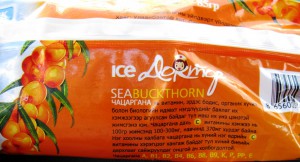
The natural history museum in downtown Ulaanbaatar has a display featuring a number of locally-made products — a couple of different oils and “globules” — along with a somewhat threadbare diorama.

I guess commercialization still has some way to go, but a start has been made. Another wild species with some commercial potential may be strawberries.
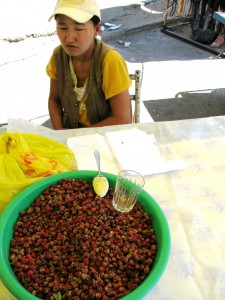
Wild Allium of various kinds is also sold in the market.
